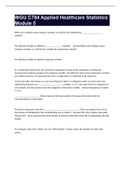Exam (elaborations)
WGU C784 Applied Healthcare Statistics Module 5 Questions and Answers (2023 Update)
- Module
- Institution
WGU C784 Applied Healthcare Statistics Module 5 Questions & Answers 2023 Update When one variable causes change in another, we call the first variable the ___________________ variable*. The affected variable is called the _______________ variable*. - (answer)When one variable causes change ...
[Show more]



